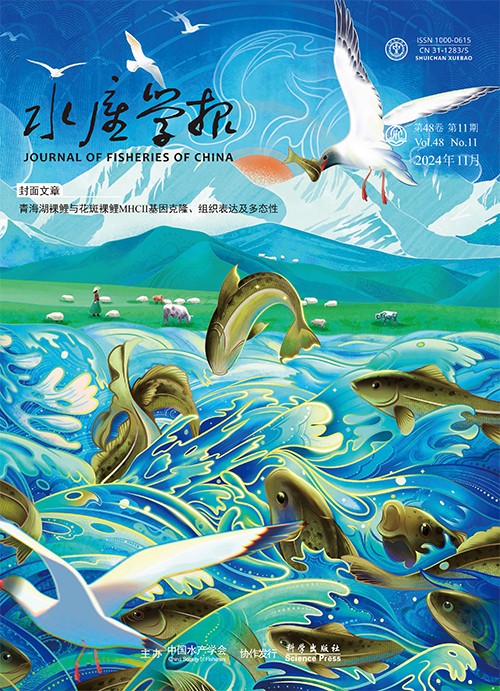凤梨酚氧化酶原cDNA克隆及表达分析
Q4 Environmental Science
引用次数: 0
摘要
澳大利亚红爪小龙虾,是一种甲壳类动物,属于十足目,副足科。近年来,红螯螯虾(Cherax quadricarinatus)的养殖不断发展,而红螯螯虾的病害是其养殖的主要因素之一,甚至导致红螯螯虾死亡。在红螯螯虾与凡纳滨对虾混养过程中发现了这种病毒性疾病。为探讨白斑综合征病毒(WSSV)感染的致病机制,采用快速扩增互补DNA末端(RACE)方法克隆了一段prophenoloxidase基因(CqproPO),研究了proPO基因在不同组织中的表达模式,以及人工感染WSSV后的血细胞、肝胰腺和鳃组织中proPO基因的mRNA表达情况。结果表明,CqproPO cDNA全长2 962 bp, ORF全长1 998 bp,编码665个氨基酸,预测分子量为75.86 ku。序列分析表明,CqproPO含有两个保守的铜结合位点;二级和三级结构分析也表明,CqproPO具有α-螺旋和β-链,与其他hc一样,具有疏水配体结合的空腔。ORF含有2个酪氨酸激酶磷酸化位点、13个酪蛋白激酶Ⅱ磷酸化位点、7个蛋白激酶C磷酸化位点、1个依赖camp和cGMP的蛋白激酶磷酸化位点和3个n -糖基化位点,这些位点是完成生理功能的结构基础。CqproPO与克拉氏原螯虾同源性分别为79%、74%、69%、67%、67%,与松毛虫、褐家鼠、美洲小家鼠、gammarus小家鼠同源性较高。real - time- pcr结果表明,CqproPO分布广泛,在血细胞中表达量最高,在肠、触角腺、鳃、卵巢和肝胰腺中表达量较少,在胃和肌肉中均有表达,而在睾丸中几乎未检测到;研究了proPO在红尾鲷血细胞、肝胰腺和鳃中的表达水平与人工感染WSSV进行比较。结果表明,CqproPO在未免疫感染组(Ⅱ组)和免疫感染组(Ⅲ组)的表达量在12 h和24h达到最大值,是对照组的1.3 ~ 2.55倍,且显著高于对照组(P0.05)。但随着感染时间的延长,酚氧化酶原基因的表达量急剧下降。感染病毒前注射免疫多糖的小龙虾(Ⅲ组)红细胞、肝胰腺和鳃中proPO基因的表达水平高于直接感染组(Ⅱ组),暴露后7 d的免疫保护率为51.86%。这些结果表明,免疫增强剂可以提高甲壳类动物对WSSV的先天抗病毒能力。本文章由计算机程序翻译,如有差异,请以英文原文为准。
cDNA cloning and expression analysis of prophenoloxidase in Cherax quadricarinatus
The Australian redclaw crayfish,Cherax quadricarinatus,is a crustacean belonging to the order Decapoda,family Parastacidae.In recent years,the cultivation of redclaw crayfish(Cherax quadricarinatus)is developing,and the disease of C.quadricarinatus was one of the major factors in its culture and even caused redclaw crayfish to die.The viral disease was found in polyculture of redclaw crayfish with Penaeus vannamei.To explore the pathogenic mechanism of C.quadricarinatus infected by WSSV(white spot syndrome virus),a prophenoloxidase gene(CqproPO)was cloned from haemocytes of C.quadricarinatus by Rapid Amplification Complementary DNA Ends(RACE)method,the proPO gene expression patterns in different tissues and the mRNA expression of proPO gene in hemocyte,hepatopancreas and gill tissues of C.quadricarinatus artificially infected by WSSV were studied.The results indicated that the full length cDNA of CqproPO consisted of 2 962 bp with a 1 998 bp Open Reading Frame(ORF),which encoded 665 amino acids,and the predicted molecular mass was 75.86 ku.Sequence analysis showed CqproPO contained two conserved copperbinding sites;The secondary and tertiary structure assay also showed that the CqproPO has α-helices and β-strands,which is delimiting a cavity where the hydrophobic ligands are bound just as other HCs.ORF contains two tyrosine kinase phosphorylation sites,13 casein kinase Ⅱ phosphorylation sites,7 protein kinase C phosphorylation sites,one dependent on cAMP-and cGMP protein kinase phosphorylation sites and three N-glycosylation sites,and these sites were structural basis of the physiological functions completed.The deduced amino acids sequence of CqproPO shared 79% homology with Procambarus clarkii and 74%,69%,67%,67% with Pacifastacus leniusculus,Nephrops norvegicus,Homarus americanus,Homarus gammarus respectively;Phylogenetic analysis revealed that CqproPO and prophenoloxidase from P.clarkii,P.leniusculus,N.norvegicus,H.americanus,H.gammarus and Panulirus longipes were in the same phylogenetic branch;The Realtime-PCR results showed that CqproPO was widely distributed,with the highest expression level in haemocytes,small amount of expression in intestine,antennal gland,gills,ovary and hepatopancreas,detectable expression level in stomach and muscle,while expression was almost undetectable in testis;The expression levels of prophenoloxidase(proPO)in haemocytes,hepatopancreas and gills from C.quadricarinatus were studied and compared by means of artificial WSSV infection.The results indicated that the expression level of CqproPO in the non-immunized infected group(group Ⅱ)and immunized infected group(group Ⅲ)reached the maximum at 12 h and 24h,which was 1.3-2.55 times higher than that in the control group,and was noticeably higher than the controls(P0.05).But the expression level of prophenoloxidase gene had sharply declined with the time extending of the infection.The expression level of proPO gene from crayfishes injected by immune polysaccharides before an infected virus(groupⅢ)were higher than the directly affected groups(groupⅡ)in haemocytes,hepatopancreas and gills,showing an immunoprotective rate of 51.86% 7 days after exposure.These observations indicated that the immunopotentiator could improve the innate anti-viral ability of the crustaceans against WSSV.
求助全文
通过发布文献求助,成功后即可免费获取论文全文。
去求助
来源期刊

水产学报
Environmental Science-Management, Monitoring, Policy and Law
CiteScore
1.40
自引率
0.00%
发文量
5213
期刊介绍:
"Fisheries of" mainly reflects the results of scientific research and development of the direction of aquaculture for domestic and foreign academic exchanges Fisheries Service. Mainly basic research published in Fisheries, aquaculture and proliferation of fishing waters environmental protection, preservation of aquatic products processing and utilization, fishing equipment, and other aspects of mechanical papers, research briefings and reviewed.
 求助内容:
求助内容: 应助结果提醒方式:
应助结果提醒方式:


